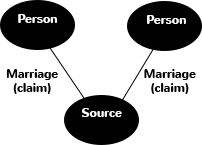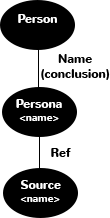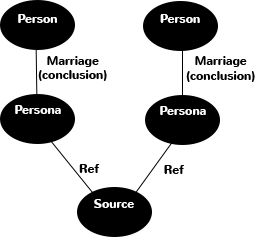The Tree Problem: Part 3 - Prepare Yourselves
23 views
Skip to first unread message
John Clark
Feb 14, 2014, 11:14:39 AM2/14/14
to root...@googlegroups.com
Preface

In Part 4 we will stop talking about the Tree Model and focus exclusively on the Graph Based System layer. In preparation for that I thought it would be helpful to show how a few of the Tree Models that RootsDev has discussed over the last few years can be implemented on top of a graph.
This part is specifically for those of you who need a more concrete visualization when discussing abstract concepts. My hope is that this part will arm you with a (simple) example tailored to your particular beliefs that you can refer to in future parts.
Please note that I am not advocating any particular model, but merely showing that any of the models discussed may be implemented on top of the Graph Based System the meets the requirements outlined in Part 1. Also, I am probably missing several models, and for that I apologize.
Please don't turn this into a Model X is better than Model Y because of Z. I have read many posts where that is debated. Again, the point is to show that any model can be implemented cleanly and meet the requirements that we specified in Part 1.
Models
For the sake of brevity I will not fully detail each model, but instead look at 2 User scenarios. 1) what is Person X's name and 2) who was person X married to. I assert that if we can show that each model can be placed on a graph, then we can focus on meeting the requirements in Part 1 by thinking about the graph in the abstract, and not using any particular model.
Note: Anything in <angle brackets> is a property on the Node or Edge.
Conclusion Model
We will start with this one first because it is the easiest.
Conclusion Based - Name

Very basic. Just an Element with a property (name).
Conclusion Based - Marriage

Also very basic. 2 Elements that reference each other.
Source Model
I quote Luther's definition found here. "You create a record representing all the information from a single source; each claim may be individually referenced. Each conclusion person refers to a claim in some source for each property it contains."
Source Based - Name

Now the name is not stored directly on the person Element, but referenced in the source Element.
Source Based - Marriage

To get a marriage we would need to follow the marriage edge to a source Element, and then follow the other marriage edge to the other person Element.
You will note that I have made some assumptions and simplifications that would not hold up to real world use, but I hope I have showed that you can represent a very basic source based model on a graph.
Persona Model
I again quote Luther's definition. "you create a record for each (person, source) pair. Each conclusion person is a collection of these personas".
Persona Based - Name

Note that there could be several personas linked to this person. In that case they would be linked as Name(s), but without the conclusion.
Persona Based - Marriage

Note that the source Element contains many properties which I did not list, and that the Ref links would need to specify which property they are linking to. Its basic, but I hope you get the idea.
STEMMA Model
I won't bother diagraming this out, as Tony Proctor has an excellent diagram here (scroll down a bit). You will note that it looks like a graph already.
Again, this is a small academic exercise to let you pick a model to hold in your head if need be when we are talking about the Graph Based system in the next few parts. And again, I know I probably didn't get the diagrams completely accurate, but I do hope that I showed that we can implement any of the above models (and many more) on this Graph Based System.
- John C.
Wayne Pearson
Feb 14, 2014, 1:22:14 PM2/14/14
to root...@googlegroups.com
My interpretation of the Persona-Based model, which seems to agree with Luther's definition, is a little different that what I'm getting from the diagrams.
The Person would/could have several Personae linked to it, *and that alone* is the conclusion; if having multiple Personae leads to differing "facts" about the Person, such as birth date, etc., then the decision on which to use (display or share as "right") is also a conclusion, but, since the evidence (in the case of two Personae) is 50/50 on the matter, your conclusion is based on ... gut feeling? There Personae, with two agreeing on the birth date, then the conclusion can say as much. History decided by quorum.
Perhaps I'm misinterpreting Luther's definition, or your diagrams; or perhaps my view of the Persona-Based model is just different.
--
---
You received this message because you are subscribed to the Google Groups "rootsdev" group.
To unsubscribe from this group and stop receiving emails from it, send an email to rootsdev+u...@googlegroups.com.
For more options, visit https://groups.google.com/groups/opt_out.
John Clark
Feb 14, 2014, 2:51:17 PM2/14/14
to root...@googlegroups.com
Hmm. In my head I pictured multiple "Name" references but only one of them would be marked as a "conclusion". I would be very interested to see a sketch of what is in your head, because I'm having a hard time visualizing the difference you are talking about.
- John C.
Wayne Pearson
Feb 14, 2014, 3:03:52 PM2/14/14
to root...@googlegroups.com
Right, your diagram shows the multiple Name references; in my mind, I see that the association between that Person and the Persona is an all-or-nothing "I accept that this Persona is this Person (as is that Persona, and that one...)". So not picking and choosing which bits of the Persona, but rather, in for a penny...
When this leads to conflicting information, then as I mentioned, you'd have to conclude which one you trust more. But in your example of referencing only part of the Persona, you're able to, say, ignore the Death date of that Persona, even if you have no other contrary information. In my mind, if you're accepting that Persona as this person, and you haven't got any contradictory information regarding the Death date, then that *is* your Death date. You might have some knowledge that it's wrong (you had lunch with him last week), but if so, put it into Evidence, link to the Persona from that Evidence, and conclude that this new Death date is the right one of two.
(You would not believe how bad I am at diagramming on a computer, but if the above still isn't quite clear, let me know and I'll open up Paint...)
John Clark
Feb 14, 2014, 3:17:57 PM2/14/14
to root...@googlegroups.com
Oh, I see. You don't have a "primary" persona, just a set, and if you have to cherry-pick parts of a persona then you accept "all parts except x" of a given persona. Makes sense now, thanks.
- John C.
Reply all
Reply to author
Forward
0 new messages
